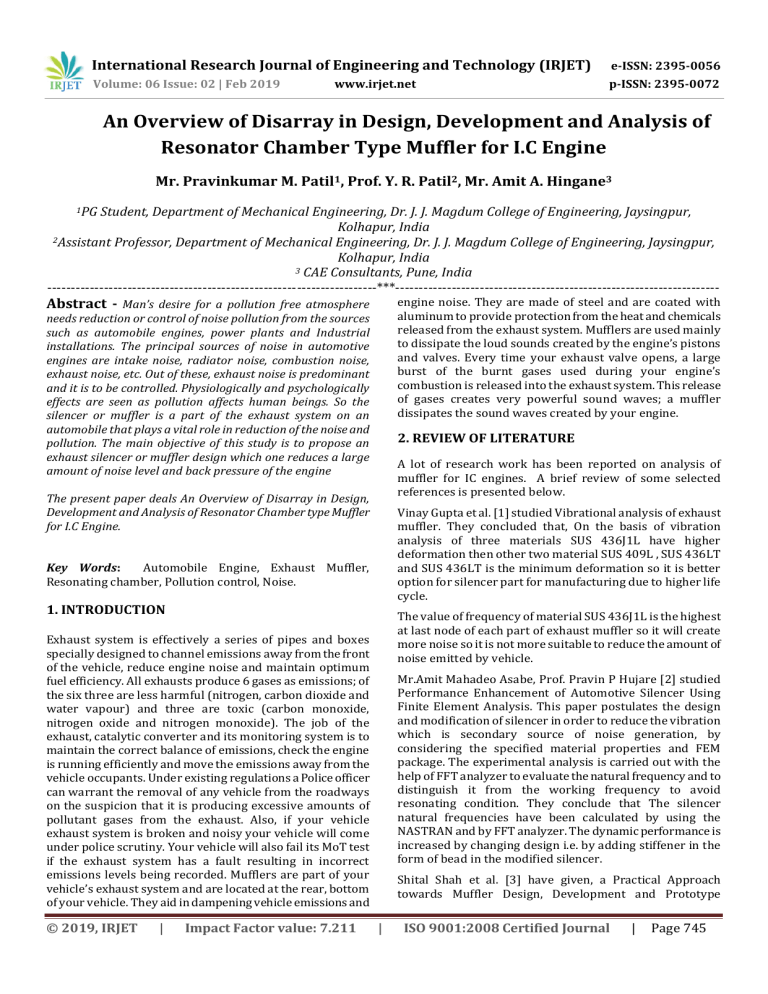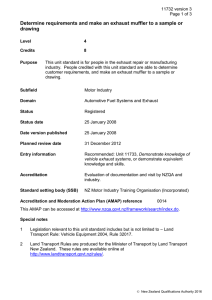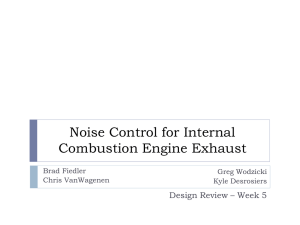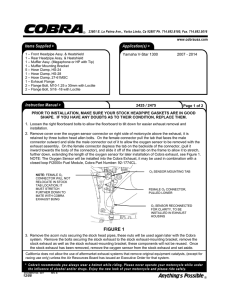IRJET- An Overview of Disarray in Design, Development and Analysis of Resonator Chamber Type Muffler for I.C Engine
advertisement

International Research Journal of Engineering and Technology (IRJET) e-ISSN: 2395-0056 Volume: 06 Issue: 02 | Feb 2019 p-ISSN: 2395-0072 www.irjet.net An Overview of Disarray in Design, Development and Analysis of Resonator Chamber Type Muffler for I.C Engine Mr. Pravinkumar M. Patil1, Prof. Y. R. Patil2, Mr. Amit A. Hingane3 1PG Student, Department of Mechanical Engineering, Dr. J. J. Magdum College of Engineering, Jaysingpur, Kolhapur, India 2Assistant Professor, Department of Mechanical Engineering, Dr. J. J. Magdum College of Engineering, Jaysingpur, Kolhapur, India 3 CAE Consultants, Pune, India ----------------------------------------------------------------------***--------------------------------------------------------------------- Abstract - Man’s desire for a pollution free atmosphere engine noise. They are made of steel and are coated with aluminum to provide protection from the heat and chemicals released from the exhaust system. Mufflers are used mainly to dissipate the loud sounds created by the engine’s pistons and valves. Every time your exhaust valve opens, a large burst of the burnt gases used during your engine’s combustion is released into the exhaust system. This release of gases creates very powerful sound waves; a muffler dissipates the sound waves created by your engine. needs reduction or control of noise pollution from the sources such as automobile engines, power plants and Industrial installations. The principal sources of noise in automotive engines are intake noise, radiator noise, combustion noise, exhaust noise, etc. Out of these, exhaust noise is predominant and it is to be controlled. Physiologically and psychologically effects are seen as pollution affects human beings. So the silencer or muffler is a part of the exhaust system on an automobile that plays a vital role in reduction of the noise and pollution. The main objective of this study is to propose an exhaust silencer or muffler design which one reduces a large amount of noise level and back pressure of the engine 2. REVIEW OF LITERATURE A lot of research work has been reported on analysis of muffler for IC engines. A brief review of some selected references is presented below. The present paper deals An Overview of Disarray in Design, Development and Analysis of Resonator Chamber type Muffler for I.C Engine. Vinay Gupta et al. [1] studied Vibrational analysis of exhaust muffler. They concluded that, On the basis of vibration analysis of three materials SUS 436J1L have higher deformation then other two material SUS 409L , SUS 436LT and SUS 436LT is the minimum deformation so it is better option for silencer part for manufacturing due to higher life cycle. Key Words: Automobile Engine, Exhaust Muffler, Resonating chamber, Pollution control, Noise. 1. INTRODUCTION The value of frequency of material SUS 436J1L is the highest at last node of each part of exhaust muffler so it will create more noise so it is not more suitable to reduce the amount of noise emitted by vehicle. Exhaust system is effectively a series of pipes and boxes specially designed to channel emissions away from the front of the vehicle, reduce engine noise and maintain optimum fuel efficiency. All exhausts produce 6 gases as emissions; of the six three are less harmful (nitrogen, carbon dioxide and water vapour) and three are toxic (carbon monoxide, nitrogen oxide and nitrogen monoxide). The job of the exhaust, catalytic converter and its monitoring system is to maintain the correct balance of emissions, check the engine is running efficiently and move the emissions away from the vehicle occupants. Under existing regulations a Police officer can warrant the removal of any vehicle from the roadways on the suspicion that it is producing excessive amounts of pollutant gases from the exhaust. Also, if your vehicle exhaust system is broken and noisy your vehicle will come under police scrutiny. Your vehicle will also fail its MoT test if the exhaust system has a fault resulting in incorrect emissions levels being recorded. Mufflers are part of your vehicle’s exhaust system and are located at the rear, bottom of your vehicle. They aid in dampening vehicle emissions and © 2019, IRJET | Impact Factor value: 7.211 Mr.Amit Mahadeo Asabe, Prof. Pravin P Hujare [2] studied Performance Enhancement of Automotive Silencer Using Finite Element Analysis. This paper postulates the design and modification of silencer in order to reduce the vibration which is secondary source of noise generation, by considering the specified material properties and FEM package. The experimental analysis is carried out with the help of FFT analyzer to evaluate the natural frequency and to distinguish it from the working frequency to avoid resonating condition. They conclude that The silencer natural frequencies have been calculated by using the NASTRAN and by FFT analyzer. The dynamic performance is increased by changing design i.e. by adding stiffener in the form of bead in the modified silencer. Shital Shah et al. [3] have given, a Practical Approach towards Muffler Design, Development and Prototype | ISO 9001:2008 Certified Journal | Page 745 International Research Journal of Engineering and Technology (IRJET) e-ISSN: 2395-0056 Volume: 06 Issue: 02 | Feb 2019 p-ISSN: 2395-0072 www.irjet.net Validation. This paper emphasizes the importance of the design methodology –a practical approach from the concept design to proto manufacturing and validation of exhaust muffler. This design methodology will help designers in understanding the importance of each step of designing in detail from concept level to validation level. This approach serves the purpose of reducing the number of iterations, product development time and cost with better design. Although the practical approach has become an important tool in making muffler design more of art than a science, the need for design verification will always be necessary at end of each step. part the muffler to improve its acoustical attenuation performance in the target frequency range. Takashi Yasuda [9] Studies on an Automobile Muffler with the Acoustic Characteristic of Low-Pass Filter and Helmholtz Resonator Based on the predictable structure, a muffler with an interconnecting hole on the tail pipe was proposed to improve its acoustic presentation. Acoustic presentation of the proposed muffler was studied experimentally and theoretically in frequency and time domain. M Rajashkumar Reeddy [10] “Explain Design And Optimization Of Exhaust Muffler In Automobiles” By Study Of Muffler Dimensions Are calculate Through The Benchmarking, To Create CAD Models The CAD models are created in CATIA V5 R19, later these CAD models of muffler are transmit to HYPER MESH for pre-processing work. Free analysis is carried out on this muffler by FEA Method using NASTRAN Software. C.J. Wu et al. [4] studied the acoustical performance prediction on single-inlet /double-outlet (SIDO) and doubleinlet/single outlet (DISO) expansion-chamber mufflers with rectangular section. Expressions for the transmission loss (TL) of this kind of mufflers are formulated by using the collocation approach. Numerical results of TL are compared with the plane wave theory to show up the higher-order mode effects. Furthermore, the finite element method (FEM) is also employed again to verify its accuracy in view of these configurations of muffler. Jun Chan investigates[11]“CFD Numerical Simulation of Exhaust Muffler based on the physical numerical carving of the flow field of the muffler” In this paper, the author simulated the field by numerical method with Fluent and analyzed the effect which the internal flow field has on the performance of the muffler. Milind s swami [5] “principle or optimization of exhaust reactive muffler” The exhaust system being the basic source of engine noise. In our modern, rapidly expanding environment one of the developing problems is that of “Noise”. In diesel engine the pollutant is let out noise. In the analysis of C.I. Engine noise the maximum sound pressure level comes out at exhaust and the acoustic power rises as load increases for all internal compression ratios. However this noise can be reduced sufficiently by means of a proper designed muffler. The suitable design and development of muffler will help to reduce the noise level but simultaneously the performance of engine should not be hampered due to back pressure created by muffler. Wang Jie Have [12]“Study On The Model Analysis Of An Automobile Exhaust Muffler Based On PRO/E And ANSYS In Order To Improve Design Efficiency” The solid model is created by PRO/E and model analysis is created out by ANSYS to study the vibration of the muffler, The natural frequencies and mode shape are considered during the design of the muffler, so avoid the resonance occurred in exhaust system. CONCLUSION From literature review it is observed that Exhaust system is one of most interesting topic for research because it predominant components in IC Engines where lot of refinements can be done in order to reduce the noise as well as other air pollutants. Some of the researchers did study on vibration characteristics of exhaust system, but noise analysis and optimizations for noise reduction is mostly untouched area, hence taking motivation from this literature study it decided to perform the Design, Development and Analysis of Resonator Chamber type Muffler for I.C Engine. Mr. Jigar H. Chaudhri [6] “Muffler Design for Automotive Exhaust Noise Attenuation - A Review” In these paper different types of mufflers and design of exhaust system belonging engine has been studied. After studying these design methods of muffler, we conclude that combination type of muffler is more effective than reactive and absorptive mufflers. Sunil and Dr Suresh P M [7] “Experimental Modal Analysis Of Automotive Exhaust Muffler Using Fem And FFT Analyzer”, which is also known as modal analysis or modal testing, deals with the specification of natural frequencies, damping ratios and mode shapes through testing under vibration. The exhaust muffler in an automobile plays an integral role in reducing the sound of the automobile. REFERENCES Jin Woo Lee [8] “Optimal Topology Of Reactive Muffler Achieving Target Transmission Loss Values: Design And Experiment”. A topology-optimization-based muffler design method for a reactive muffler is nominate and experimentally validated. In a reactive muffler design problem, rigid partitions should be located optimally inner © 2019, IRJET | Impact Factor value: 7.211 | [1] Vinay Gupta, Dhananjay Kr. Singh1, Dhirendra kr. Singh1, Madan Mohan Mishra1, Satish Kumar Dwivedi, Ajay Yadav, Vibrational analysis of exhaust muffler. IJSER Volume 4, Issue 6, June-2013. [2] Mr.Amit Mahadeo Asabe, Prof. Pravin P Hujare, Performance Enhancement of Automotive Silencer Using Finite Element Analysis.www.ijesi.org Volume 3 Issue 8, August 2014 ,PP.14-22. ISO 9001:2008 Certified Journal | Page 746 International Research Journal of Engineering and Technology (IRJET) e-ISSN: 2395-0056 Volume: 06 Issue: 02 | Feb 2019 p-ISSN: 2395-0072 www.irjet.net [3] Shital Shah, Saisankaranarayana K, Kalyankumar S. Hatti, Prof. D. G.Thombare have given, a Practical Approach towards Muffler Design, Development and Prototype Validation.SAE International 2010. [4] C.J. Wu, X.J. Wang, H.B. Tang, Transmission loss prediction on SIDO and DISO expansion-chamber mufflers with rectangular section by using the collocation approach. ELSEVIER Science Direct Applied Acoustics 69 (2008) 173–178. [5] Milind s swami “Design principle and optimization of exhaust reactive muffler” International Engineering Research Journal(IERJ) Volume 1 Issue 5 page 335340ISSN2395-1621,2015 [6] Mr. Jigar H. Chaudhri “ Muffler Design for Automotive Exhaust Noise Attenuation - A Review” Int. Journal of Engineering Research and application, ISSSN:22489622, Vol. 4, pp.220-223,2014 [7] Sunil And Dr Suresh P M “Experimental Modal Analysis Of Automotive Exhaust Muffler Using Fem And FFT Analyzer” International Journal of Recent Development in Engineering and Technology Volume 3 Issue 1,page 185-187 ISSN 2347-6435, 2014 [8] Jin Woo Lee “Optimal Topology Of Reactive Muffler Achieving Target Transmission Loss Values: Design And Experiment”, Content lists available at science direct, Applied Acoustic 88,page 104-113,2014 [9] Takashi Yasuda Studies On An Automobile Muffler With The Acoustic Characteristic Of Low-Pass Filter And Helmholtz Resonator, Department of Integrated engineering ,Hiroshima kokusai, Japan, page 7390321,2013 [10] M Rajashkumar Reeddy “Explain Design And Optimization Of Exhaust Muffler In Automobiles” International Engineering Research Journal, Volume 2, page 395-398 ISSUE 2012 [11] Jun Chan investigates “CFD Numerical Simulation of Exhaust Muffler based on the physical numerical modeling of the flow field of the muffler” Int. Journal of Engineering Research and application, ISSSN:22489622, Vol. 4, pp.220-223,2011 [12] Wang Jie Have “Study On The Model Analysis Of An Automobile Exhaust Muffler Based On PRO/E And ANSYS In Order To Improve Design Efficiency” Int. Journal of Engineering Research and application, ISSSN:2248-9622, Vol. 4, pp.220-223,2010 © 2019, IRJET | Impact Factor value: 7.211 | ISO 9001:2008 Certified Journal | Page 747



